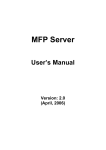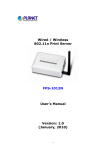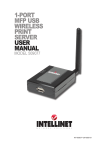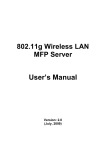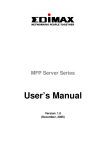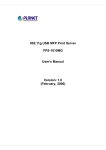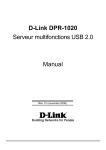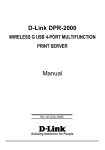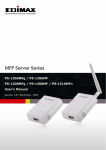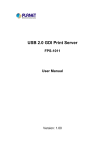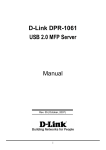Download Edimax PS-1206MF USB Print Server for MFPs
Transcript
Fast Ethernet MFP Server User’s Manual Version: 2.0 (August, 2006) COPYRIGHT Copyright ©2006/2007 by this company. All rights reserved. No part of this publication may be reproduced, transmitted, transcribed, stored in a retrieval system, or translated into any language or computer language, in any form or by any means, electronic, mechanical, magnetic, optical, chemical, manual or otherwise, without the prior written permission of this company. FCC COMPLIANCE STATEMENT This device complies with Part 15 of the FCC Rules. Operation is subject to the following two conditions: (1) this device may not cause harmful interference, and (2) this device must accept any interference received, including interference that may cause undesired operation. Any changes or modifications not expressly approved by the party responsible for compliance could void the authority to operate equipment. DISCLAIMER This company makes no representations or warranties, either expressed or implied, with respect to the contents hereof and specifically disclaims any warranties, merchantability or fitness for any particular purpose. Any software described in this manual is sold or licensed "as is". Should the programs prove defective following their purchase, the buyer (and not this company, its distributor, or its dealer) assumes the entire cost of all necessary servicing, repair, and any incidental or consequential damages resulting from any defect in the software. Further, this company reserves the right to revise this publication and to make changes from time to time in the contents hereof without obligation to notify any person of such revision or changes. Contents 1. 2. 3. 4. Introduction ...................................................................... 1 Product Package ............................................................. 2 MFP Server with Print Server .......................................... 3 MFP Server Installation in Windows 2000/XP ................. 5 4.1 4.2 4.3 4.4 Hardware Installation ....................................................... 5 Software Installation......................................................... 6 MFP Server Utilities ....................................................... 15 MFP Drivers/Utilities Installation .................................... 16 4.4.1 Never Install MFP Driver/Utilities .......................................17 4.4.2 MFP Drivers/Utilities has been installed ............................20 5. Using the MFP ............................................................... 22 5.1 5.2 5.3 5.4 Printing........................................................................... 23 Scanning ........................................................................ 24 Card Reader Accessing ................................................. 25 Faxing a File .................................................................. 26 6. MFP Manager ................................................................ 28 6.1 6.2 6.3 6.4 6.5 MFP Server List ............................................................. 28 My Favorite .................................................................... 31 Auto Connect List........................................................... 33 Quick Setup ................................................................... 36 Option Settings .............................................................. 38 6.5.1 General Setting .................................................................38 6.5.2 Search for MFP Server......................................................39 7. Server Configuration...................................................... 40 7.1 7.2 7.3 7.4 7.5 7.6 7.7 7.8 Introduction .................................................................... 40 Search for All Available MFP Server .............................. 41 Status of MFP Server ..................................................... 42 Setup the MFP Server.................................................... 43 General Configuration .................................................... 44 TCP/IP Configuration ..................................................... 45 System Configuration..................................................... 47 MFP Server Management .............................................. 48 7.9 Report ............................................................................ 49 8. Web Management ......................................................... 50 8.1 8.2 8.3 Introduction .................................................................... 50 Login .............................................................................. 51 Device Status ................................................................. 52 8.3.1 System Status ...................................................................52 8.3.2 Printer Status.....................................................................53 8.3.3 TCP/IP Status....................................................................54 8.4 Setup Wizard ................................................................. 55 8.4.1 System ..............................................................................55 8.4.2 TCP/IP...............................................................................57 8.4.3 Save Settings ....................................................................58 8.5 System Tools.................................................................. 59 8.5.1 Load Default ......................................................................59 8.5.2 Upgrade Firmware.............................................................60 9. LPR Printing................................................................... 61 10. RAW Printing ................................................................. 67 11. IPP Printing .................................................................... 73 11.1 11.2 Introduction .................................................................... 73 System Setup................................................................. 73 11.2.1 MFP Server Side ...............................................................73 11.2.2 Client Side .........................................................................73 12. MFP Server Installation in Windows 98SE/Me/NT ........ 78 12.1 12.2 12.3 12.4 Software Installation....................................................... 79 Server Utilities ................................................................ 86 Network Port Setup ........................................................ 87 Add Printer ..................................................................... 88 13. UNIX/Linux System Network ......................................... 92 13.1 13.2 GUI Mode....................................................................... 92 Console Mode................................................................ 96 13.2.1 Enable MFP Server’s TCP/IP Support...............................97 13.2.2 Setup MFP Server’s IP Address ........................................97 13.2.3 Verify MFP Server’s IP Address ........................................99 13.2.4 Configure Remote LPD Printing on the Host ................... 100 14. MFP Server Installation in MAC OS............................. 102 14.1 14.2 MAC 10.4.x .................................................................. 102 MAC 10.3.x .................................................................. 103 15. Troubleshooting ........................................................... 107 Appendix: MFP Server Compatibility List .......................... 110 1. Introduction Thank you for purchasing our MFP server. This MFP server allows your multi-functions, all-in-one printer (MFP) or printer to be shared in the network. Unlike other print servers, it can communicate with MFP and printer as if it is connected directly to your computer. Because of the features, all users can share print, scan, card reader and fax functions through the network. Furthermore, the MFP Server can build the bi-directional communication with MFPs and printers so that it can help to monitor important information such as ink level and paper level. The MFP server supports print, scan, card reader and fax sharing functions in the most popular operating systems: Windows 2000 SP4 above and XP SP1 above. It also supports Windows XP scanning utility and MFP vendors’ scanning utilities. When you want to scan in the Windows XP, you can choose one of the utilities. Not only a MFP Server, but also this MFP Server is a traditional print server. It supports TCP/IP network protocol and LPR, RAW and IPP printing protocols. It can share print function in the various common network operating systems including Windows 98SE/Me/NT/2000/XP/2003, Unix, Linux and MAC OS 9.x above. The MFP server is the best solution for users to share MFP or printer conveniently and easily. It offers the most flexibility and manageability for MFP or printer in your local area network at an extremely low cost and with a minimum setup and maintenance required. 1 2. Product Package This package contains the following components: One MFP Server One Power Adapter One Quick Installation Guide One CD-ROM (Including all the software utilities, drivers, multi language QIG and User’s Manual) 2 3. MFP Server with Print Server This MFP Server supports dual functionalities: MFP Server Mode and Print Server Mode at the same time. Users can choose one of the modes to share MFP or Printer functions through the MFP Server. MFP Server Mode: The MFP Server can communicate with MFP as it is connected directly to your computer. This enables users to share MFP for printing, scanning, card reader and faxing. If the MFP Server is connected to a printer but not MFP, users still can share printing function through the operation mode. The supported OS in this mode is Windows 2000 SP4 above and Windows XP SP1 above. The MFP Server mode doesn’t support Windows 98SE/ME/NT, Linux/Unix or MAC OS. For the detailed applications, please refer to the following chapters. Chapter 4: MFP Server Installation in Windows 2000/XP Chapter 5: Using the MFP Chapter 6: MFP Manager 3 Print Server Mode: The MFP Server also supports LPR, IPP and RAW printing protocols, which enable users to share printing function of MFP or Printer. The supported OS is Windows 98SE/Me/NT/2000/XP/2003, Unix, Linux and MAC OS 9.x above. For the detailed applications, please refer to the following chapters. Chapter 9: LPR Printing Chapter 10: RAW Printing Chapter 11: IPP Printing Chapter 12: MFP Server Installation in Windows 98SE/ME/NT Chapter 13: Unix System Network Chapter 14: MFP Server Installation in MAC OS 4 4. MFP Server Installation in Windows 2000/XP Before you start, you should have: One computer with Windows 2000 SP4 above and Windows XP SP1 above One MFP or printer with USB port and an installation CD One Category 5 Ethernet Cable One USB Cable 4.1 Hardware Installation Procedure 1. Unpack the MFP Server package and verify that all the items listed in the previous section are included. 2. Plug the USB cable to the MFP Server and the MFP or printer that you want to share on the network. 3. Connect the MFP Server to your network by attached the network cable to the network port of the MFP server. 4. Connect the power adapter to the MFP Server. The MFP Server will perform the Power-On-Self-Test (POST) after it is powered on. When the Status LED is off, the MFP Server is ready. Note: 1. You must use the power adapter shipped along with the MFP Server, do NOT use any other power adapter from other sources. 2. To prevent the compatibility problem between MFP Server and a few MFP or printer, it is recommended that you power on the MFP Server before the MFP or printer. 5 4.2 Software Installation Procedure Before you start, you should check your computer’s operating system. This program can be run only in Windows 2000 SP4 above and Windows XP SP1 above. Please follow the steps below to start installation. Tip: You have to uninstall all the MFP server drivers and utilities if you have installed the previous version. 1. Insert the CD shipped along with the MFP Server into your CD-ROM drive. The Autorun.exe program should be executed automatically. If not, run Autorun.exe manually from CD-ROM drive’s root directory 2. The following screen will be displayed. Click “Setup Utility”. 6 3. The “MFP Server Utilities - InstallShield Wizard” is displayed, click "Next". 7 4. Click “Next” to install the MFP Server utilities in the default folder or click “Change” to specify the destination folder where you would like to install the MFP Server utilities. 8 5. The system starts installing the MFP Server Utilities. 6. The MFP Server is installing the MFP Server utilities. When you find the following screen, please click “Continue Anyway”. 9 7. The MFP Server is installing the MFP Server drivers. When you find the following screen, please click “Continue Anyway”. 8. The “MFP Server Configuration” screen is displayed. If you want to configure the MFP Server, please click “”Next” directly. Or you can select “No, I will configure the MFP Server later” and click “Next” to complete the installation. The following steps are for MFP Server Configuration. 10 9. The MFP Server List will auto search the MFP Servers in the network. Select the MFP Server you wan to setup and click “Next” to continue. 10. Enter the “User Name” and “Password” of the MFP Server you have selected to login the MFP Server. The default “User Name” is “admin”; default “Password” is “1234.” 11 11. Set the “Alias Name” and the “MFP Server Description” to the MFP Server here. Click on “Next”. Note: You can give a description by filling “MFP Server Description” to the MFP Server so you can find it easily later on. 12 12. Please set the network settings for the MFP Server manually. By default, the network settings are as follows. IP Address: 192.168.2.2 Subnet Mask: 255.255.255.0 If you select “DHCP”, the MFP Server will try to determine your network settings automatically. If a DHCP Server is present within the network, the MFP Server will automatically obtain and configure the network settings from the DHCP Server. The assigned IP Address will be shown in the IP Address fields. If no DHCP Server is present within the network, please assign the network settings of the MFP Server manually. Please click “Next” once you have found appropriate network settings for the MFP Server. Note: The MFP Server IP Address should be in the same network segment with the connected computer. If the network settings are incorrect, a message will be prompted to remind you after you click “Next”. Please make sure that you have set the right settings before going to the next step. If you don’t want to set it now, please click “Cancel” to finish the installation. You can then use the “Server Manager” utility to configure the MFP Server. 13 13. The configurations are finished. Please click “Finish” to apply new settings. 14. Click “Finish” to complete the installation. Note: If the Windows XP Firewall in your system has been enabled, the MFP Server will automatically open ports for the MFP Server programs smoothly run in your system. It will not cause abnormal behaviors or unsafe on your system. 14 15. Choose if you want to run the “MFP Manager” utility automatically when Windows starts. It is recommended to enable the setting. 4.3 MFP Server Utilities After the installation is completed, there will be three utilities and a text file in the MFP Server’s Program folder. MFP Manager – Allows you to manage the connection between the MFP and your computer for sharing MFP function. Server Manager – Allows you to configure the MFP Server’s IP Address, network protocols and other advanced features. It also allows you to manage the MFP Server. Uninstall – Assistant for removing all installed MFP Server software programs. About Version – Display the version of each utility including in the MFP Server software programs. 15 4.4 Install the MFP Drivers/Utilities When the installation is completed, the “MFP Manager” will be popped up. It will automatically find the MFP Servers and the connected MFPs in the network and show it in the “MFP Server List”. Before you start to install the MFP in the “MFP Server List”, please check your computer’s MFP installation status. You never install the MFP drivers/utilities; please refer to the Section 4.4.1. You have installed the MFP drivers/utilities; please refer to the Section 4.4.2. 16 4.4.1 Never Install MFP Driver/Utilities Before the installation, please read the manual of the MFP. Some MFP requires users to install the drivers/utilities before connecting the MFP to your computer. Some MFP requires connecting the MFP to your computer during the installation. Please refer to the below illustration of “HP ALL-In-One Series” which is the screen displayed during the installation. To connect the MFP to your computer through the MFP Server just like you have directly connected the MFP to your computer through the USB cable, you can follow the steps below. 17 1. Select the MFP that you wan to install in the “MFP Server List” and click “Connect” button. 2. The Windows will detect the new hardware and prompt to install the MFP drivers. Follow the screens to finish the installation. If the system can’t find the MFP driver, please insert the installation CD of the MFP and find drivers in the CD manually. Note: If the MFP you have connected is a composite device, the system will install the driver for composite device at first. The following screen will be popped up, please click “Continue Anyway”. Follow the screens to finish the installation. If the system can’t find the MFP driver, please insert the installation CD of the MFP and find drivers in the CD manually. 18 3. After you have completed the MFP installation, you will see the MFP is added to the “Printers and Faxes” in Windows. 19 4.4.2 MFP Drivers/Utilities has been installed 1. To link the MFP drivers/utilities that you have installed to the MFP Server, please follow the steps below. Select the MFP that you want to install in the “MFP Server List” and click “Connect” button. 2. The Windows will detect the new hardware and prompt to install the MFP drivers. Follow the screens to finish the installation. If the system can’t find the MFP driver, please insert the installation CD of the MFP and find drivers in the CD manually. Note: If the MFP you have connected is a composite device, the system will install the driver for composite device at first. The following screen will be popped up, please click “Continue Anyway”. Follow the screens to finish the installation. If the system can’t find the MFP driver, please insert the installation CD of the MFP and find drivers in the CD manually. 20 3. After the installation, a copy of the MFP will be added to the “Printers and Faxes” in Windows. Tip : The new copy of the MFP is linked to the MFP Server. Please use this MFP to share print, scan, card reader or fax functions through the network. 21 5. Using the MFP After you have installed the MFP thought the installation wizard , the MFP is now connected to your computer. You can start sharing print, scan, card reader or fax function provided by the MFP. Tip 1: If you have finished using the MFP, please click “Disconnect” to release the MFP. Other users can’t use the MFP only if the MFP is released. Tip 2: It is recommended to enable “Auto Release” setting. The MFP Server will release the connection with the MFP after a period of idle time that you have assigned. In this way, the MFP will not be occupied too long and other users can share the MFP frequently. Please refer to Section 6.1 for more information. 22 5.1 Printing The MFP will be added to “Printers and Faxes” in the Windows after the MFP is installed. When you connect to the MFP by clicking “Connect” in the “MFP Manager”, the MFP Server will create the connection between the MFP and your computer and then you can print a document just follows the same steps as usual. Tip: If you have sent a printing job to the MFP while the MFP is connecting by a user, you may be prompted that the device is not found or the document is failed to print. Please resend the printing job after the MFP is idle or not being connected by the other user. 23 5.2 Scanning Most of the MFP provides scan utility for users. You can scan pictures or documents through the utility. In Windows XP, user can also scan from Windows XP scanning utility. An example: HP 1600 Series Utilities Windows XP Scanning Utility 24 5.3 Card Reader Accessing If the MFP supports card reader function, you can read the files in the plugged card reader through the MFP Server. 25 5.4 Faxing a File If the MFP supports fax function, you can fax files from your computer to the fax number you designated. An example: Fax through HP Officejet 5600 Series After the MFP is installed, a fax device will be added to “Printers and Faxes” in the Windows. When you connect to the MFP by clicking “Connect” in the “MFP Manager”, you can fax a file through the MFP Server. Procedures to fax a file 1. In the Microsoft Office or other programs, select “Print” from the “File” menu. 2. The following screen will be popped up, select the fax device and then click “Print”. 26 3. The “Send Fax” screen is popped up, please configure the file and enter the fax number. Click “Send Fax” to fax the file. 27 6. MFP Manager 6.1 MFP Server List The “MFP Manager” can automatically find the MFP server in the network and show it in the MFP Server List. Users can select a MFP and click “Connect” to connect the MFP just like you connect the MFP directly to your computer through USB cable. It also displays the connection status information. When you don’t want to use the MFP or Printer, please click “Disconnect” so other users can use the device. You can also enable the “Auto Release” setting, so that the MFP Server will release the connection after a period of idle time that you have assigned. If you unplug the USB cable or turn off the MFP while using, the device will not display in the list. After you reconnect the USB cable or turn on MFP, you have to click “Refresh” and “Connect” buttons in the “MFP Manager” to recover the connection. 28 MFP Server List MFP Server List The “MFP Server List” will list all the MFP Servers within the network. You can find the information of the MFP Servers including “MFP Server Name”, “MAC ID”, “IP Address” and the device connected to the MFP Server. MFP Server/MFP When you click on the “MFP Server” in the “MFP Server Information List”, you will see the “MFP Server Description” and the “Idle Timeout” setting for the MFP Server. MFP Server Description – It is a description that can help users to identify MFP Server. Idle Timeout –– From here, each user can know his/her auto release setting. To avoid occupying the MFP overtime, each user can enable the “Auto Release” setting at the bottom of the “MFP Manager” utility. It is used to automatically disconnect the connection after the MFP is idle for a specified period of time. By default, it is never released. When you click on the “MFP” in the “MFP Server List”, you will see the information including “Status”, “Computer Name” and “Contact Information”. Status – It displays the status of the MFP including Connected, Idle and Busy. When the status is “Connected”, it indicates that MFP is connected. When the status is “Idle”, it indicates that the MFP is not being used. When the status is “Busy”, it indicates that other user is using the MFP to scan, print, or etc. Computer Name – It display the computer name of the user who is connecting to the MFP. Contact Information – When the current user has set 29 his “Contact Information”, you can see it here. You can contact with the current user asking to disconnect the MFP. Refresh Refresh the “MFP Server List” immediately. Connect Connect the MFP. Disconnect Disconnect the selected MFP. Add to My Favorite Add the MFP Servers that you frequently use to “My Favorite List”. Auto Release when To avoid you occupy the MFP overtime; you can setup idle time is over xx auto release function. It is used to automatically minutes (5-255) disconnect the current connection after the MFP is idle for a specified period of time. By default, it is never released. It is recommended to enable the setting after the MFP and MFP Server are installed completely so that the MFP resource will not be occupied permanently. 30 6.2 My Favorite You can add the frequently use MFP Servers to “My Favorite” list. The MFP Server in the list will be added to the quick link list when you right click the MFP Server icon in the system tray. Please refer to Section 6.4 to know more about the quick setup functions. My Favorite List My Favorite List The “My Favorite List” will list your favorite MFP Servers. You can find the information of the MFP Servers including “MFP Server Name”, “MAC ID”, “IP Address” and the device connected to the MFP Server. MFP Server/MFP The information listed here are the same as MFP Server Information List. Please refer to Section 6.1. Refresh Refresh the “MFP Server List” immediately. Connect Connect the MFP. 31 My Favorite List Disconnect Disconnect the selected MFP. Delete Delete the selected MFP Server from the “My Favorite List”. Auto Release when To avoid you occupy the MFP overtime; you can setup idle time is over xx auto release function. It is used to automatically minutes (5-255) disconnect the current connection after the MFP is idle for a specified period of time. By default, it is never released. It is recommended to enable the setting after the MFP and MFP Server are installed completely so that the MFP resource will not be occupied permanently. 32 6.3 Auto Connect List To let the system connect the MFP server automatically when you want to print a document just like using traditional print server, you can add the MFP into your Auto Connect List. The system will send the printing jobs to the MFP when the MFP Server is idle and not being connected. Tip: If you send a printing job to the MFP while the MFP is connecting by the other user, you may be prompted that the device is not found or the document is failed to print. It also happens in some MFPs or printers even though the MFP is not connecting by a user. Please follow the message to retry and the MFP will queue your printing job in your computer spooler. The MFP Server will then print the job after the MFP is idle or disconnected. To add the MFP to the Auto Connect List, please follow the steps below. 1. Click “Add” from the “Auto Connect List”. 33 2. The MFP Servers within the network will be displayed in the following screen. Select the MFP Server you would like to add to the list. 3. Select the MFP that is connected to the selected MFP Server. Click “Ok”. Note that in some cases, a printing jobs cannot be printed completed if the MFP is already disconnected. It will print unformatted messages. “Keep connecting for 30 second(s) after printing has been finished (5-60)” is enabled by default. It will help to avoid this kind of situation. 34 4. The setup is finished. 35 6.4 Quick Setup Right click on the MFP Server icon in the system tray you can see the MFP servers you have chosen to “My Favorite List”. You can directly connect or disconnect the MFP and check the MFP information from the here easily. Quick Setup Status The current status of the MFP will be displayed here. “Connected” indicates that you are connecting to the MFP. “Busy” indicates the MFP is being used. “Idle” indicates that the MFP is free to use by any users. Connect If the MFP is free to use, the “Connect” is available to click for connecting the MFP. Otherwise, it is grayed out. 36 Quick Setup Disconnect Disconnect the selected MFP. The “Disconnect” is available only for the current user. Information To check more information about the MFP Server and the MFP, please click this button. The information will be shown as above. 37 6.5 6.5.1 Option Settings General Setting General Setting Run MFP Manager when Execute the “MFP Manager” when Windows starts Windows starts every time. By default, it is enabled. Minimized when start Minimized the “MFP Manager” to an icon in the MFP Manager system tray when you start the “MFP Manager”. By default, it is disabled. Refresh status every xx Setup the refresh interval for device status update. seconds. (5~300) By default, it is disabled. Your Contact Information Enter your contact information here. When you connect to the MFP, your contact information will be displayed in the right side of the program for other users to contact you. 38 6.5.2 Search for MFP Server If there is an MFP Server not in the same network as your computer, you can enter the IP Address of the MFP Server for the remote search. The MFP Server in the “Remote MFP Server List” will be added to the “MFP Server List” for you to configure. Note: If the remote MFP Server you searched is behind NAT Router, the MFP Server may not operate normally. 39 7. Server Configuration 7.1 Introduction This chapter introduces MFP Server’s system configuration utility in Windows environment. This utility provides the most complete management and configuration functions on the MFP Server This utility only provides configuration functions for MFP Server itself; it does not include configuration functions for client side or other file server in the network environment. The Configuration Utility provides the following configuration and management functions: Search MFP Server: Search All Available MFP Servers on the Network. Status: Display MFP Server Network Status. General Configuration: Configure general settings about the MFP Server such as Server Name, Password, etc. TCP/IP Configuration: IP Address and DHCP Server Configuration. System Configuration: MFP Server Network Ability Setting and Firmware Upgrade. MFP Server Management: For administrator to manage the MFP Server. Administrator can force to disconnect the current connection of the MFP Server. Report: List the some information of All Available MFP Servers in the Network. We will explain each function separately in the following section. 40 7.2 Search for All Available MFP Server Every time when you run the “Server Manager” configuration utility, click the “Search” icon on the tool bar. The configuration utility will delay for several seconds as the utility uses system’s available network protocols to search for all MFP Servers on the network. All available MFP Servers will be listed under “Server Group” on the left side of the window. You must select the MFP Server you would like to configure from the list. The system will, at the same time, display the selected MFP Server’s status on the right side of the window. 41 7.3 Status of MFP Server Click “Status” icon on the tool bar, the status of the selected MFP Server will be showed on the right side of the window. The information of the MFP Server includes MAC ID, Model Type, Firmware Version, status of each server port, IP address, subnet mask, default gateway and supported printing protocols…etc. You can refresh the MFP Server’s status by pressing the “Refresh” button . You can restart the MFP Server by pressing the “Reboot” button 42 . 7.4 Setup the MFP Server Click “Setup” icon on the tool bar, the setup items of the selected MFP Server will be showed on the right side of the window. Double click the icon to set up the selected MFP Server. A screen will pop up to verify “User Name” and “Password” of the MFP Server. The default values are: User Name: admin, Password: 1234. Tip: When you finish the settings, please click “ Server to take the settings effect. 43 ” to restart the MFP 7.5 General Configuration Double click “General” icon and the General configuration window will pop-up. You can see basic MFP Server information in this page. You also can configure the “Server Name”, “User Name” and “Password” here. Server Name, the name of the MFP Server. You can use this name to identify the MFP Server when you search for the MFP Server by the “Server Manger” utility. User Name / Password is used to authenticate the administrator to login the MFP Server to configure it from the “Server Manger” utility or the Web Management tool. 44 7.6 TCP/IP Configuration Double Click “TCP/IP” icon and the TCP/IP configuration window will pop-up. You can configure the MFP Server to get IP automatically from DHCP server or specify static IP manually. The MFP Server also has a built-in DHCP server. You can enable this DHCP server and let it manages IP for you. 45 IP Address Assignment: Click the “IP” button to enter the IP setting page. If you need the MFP Server to automatically get an IP from DHCP server, select “Auto IP”. You also can select “Static IP” to manually assign “IP Address”, “Subnet Mask” and “Gateway” for the MFP Server. By default, “Static IP” is enabled and the default settings are as follows. IP Address: 192.168.2.2 Subnet Mask: 255.255.255.0 Auto IP – The IP Address information of the MFP Server obtained from DHCP Server will be displayed in the address field. If no DHCP Server is present, you have to assign the information manually. Static IP – Manually assign the IP address information in the same network with your computer to the MFP Server. DHCP Server: Click the “DHCP Server” button to enter into the DHCP server’s setting page. By the default, the DHCP server is disabled. Auto – If “Auto” is selected, the MFP Server will detect DHCP server within the network automatically and once the DHCP server doesn’t exist, the MFP Server will turn on his own DHCP server and assign IP Address to client. Please fill in the “Starting Address”, “Range”, “Subnet Mask”, “Gateway” and “DNS”; then the MFP Server will assign a unique IP within the range for each DHCP client. Enable – If the DHCP is enabled, you have to assign a range of IP addresses. Fill in the “Starting Address”, “Range”, “Subnet Mask”, “Gateway” and “DNS”; then the MFP Server will assign a unique IP within the range for each DHCP client. Disable – The DHCP Server is disabled. You have to build up a DHCP Server in the network or set the IP Address for each client manually. 46 7.7 System Configuration Double Click “System” icon and the System configuration window will pop-up. In the System configuration page, you can see all available printing protocols and upgrade the new firmware for this MFP Server. Upgrade Firmware: You can use this “Upgrade Firmware” tool to update the newest firmware of the MFP Server. Click “ ” button and select the correct firmware in your PC. After selecting the firmware file, click the “Upgrade” button to finish the firmware update process. Tip: Before you upgrade the firmware, please make sure that the IP Address settings of the MFP Server are in the same network as your computer. Load Default: If you want to reset the MFP Server to default factory settings, please click “Load Default”. 47 7.8 MFP Server Management Double Click “MFP Server Management” icon and the MFP Server configuration window will pop-up. You are able to manage the MFP Server as below. Force Release: Select the port number and then click “Force Release” will help to you disconnect the current connection between the user and the connected device. It is very useful when a user forgets to disconnect the MFP, administrator can force to disconnect the connection and let the MFP be free to use. MFP Server Description: Enter the description (max 15 alphanumeric) of the MFP Server such as location or other information to help user to find the MFP Server easily. 48 7.9 Report Click “Report” icon on the tool bar, the Report window will pop up. The report lists basic information of all available MFP Servers in the network. The information includes Device Name, MAC ID, Model Type and Firmware Version of MFP Server. 49 8. Web Management 8.1 Introduction MFP Server can be configured and managed by a Web browser. Through Local Area Network, or even Internet, administrator can easily configure and manage MFP Server’s various main functions by the browser. Simply enter MFP Server’s IP address into the browser’s address bar to access the MFP Server setup page. The default IP Address, User Name and Password settings of the MFP Server are as follows. IP Address: 192.168.2.2 User Name: Admin Password: 1234 50 8.2 Login You may use any Web Browser to review the status or configure the settings of the MFP Server. After entering the IP address of the MFP Server, a login page display. You have to enter correct “User Name” and “Password” before going to the Web Management pages. Note: Default User Name is “admin”, default password is “1234”. 51 8.3 8.3.1 Device Status System Status System Information includes “Device Name”, “MFP Server Name”, “Model Type”, “Firmware Version”, “MAC Address”, “Wireless LAN Status”, and the protocols enabled status, etc. 52 8.3.2 Printer Status This page lists the information and the status of MFP or printer connected to the MFP Server port. The status of the MFP or printer includes “Connected”, ”Ready”, “Off Line” or “Paper Out”. Connected: the MFP or printer is connected by a user. Ready: the MFP or printer is not connected by a user and is ready to use. Off Line: the MFP or printer is not connected by a user and is not connected to MFP Server through USB cable or it is turned off. Paper Out: the MFP or printer is not connected by a user and is paper out. 53 8.3.3 TCP/IP Status This page lists all TCP/IP settings of the MFP Server including “IP Address”, “Subnet Mask” and “Gateway”. It also can tell the DHCP server is “On” or “Off”. 54 8.4 Setup Wizard Note: You can configure the MFP Server from the Setup Wizard. To apply the changes, you have to click “Save Settings” in the menu at the left side to restart the MFP Server. 8.4.1 System You can change the MFP Server name and password of the MFP Server here. MFP Server Name, the name of the MFP Server. You can use this name to identify the MFP Server when you search for the MFP Server by the “Server Manager” utilities. Password, enter the password you want to change to the MFP Server. The password can be up to 7-digit alphanumeric format. The default password is “1234”. Re-types Password, enter the same password for the MFP Server again. 55 8.4.1.1 Advanced Settings Some advanced feature of the MFP Server can be set here. TCP/IP Printing: This MFP Server supports TCP/IP network protocol and LPR/IPP/RAW printing protocols. By default these protocols are enabled. 56 8.4.2 TCP/IP You can configure the MFP Server to get IP automatically from DHCP server or setup an static IP manually. If you need the MFP Server to automatically get an IP from DHCP server, select “Enable Obtain TCP/IP Settings Automatically (Use DHCP/ BOOTP)”. You also can select “Disable Use the following TCP/IP Settings” to manually assign “IP Address”, “Subnet Mask” and “Gateway” for the MFP Server. 57 8.4.3 Save Settings After configuring the MFP Server, you have to click the “Save Settings” to save the settings and restart the system. 58 8.5 8.5.1 System Tools Load Default You can use this page to restore the factory default settings. All of your previous setup will be reset. 59 8.5.2 Upgrade Firmware You can upgrade the latest firmware for this MFP Server in this page. Click “Browse” to select the firmware in your storage and then click “OK”, the firmware will be updated in several minutes. Be aware that if you have started upgrading firmware, you have to follow all the upgrading steps. Otherwise the MFP Server will not operate normally. 60 9. LPR Printing LPR Printing (Line Printer Remote technology) allows users to connect to MFPs or printers via TCP/IP for printing sharing. The computer with Windows 98SE/Me/NT/2000/XP/2003 operating system can use the protocol to share printing in the network. MFP Server can support LPR printing by default. If you install the MFP Server in Windows 98SE/Me/NT, the MFP Server provides a tool “Network Port Setup” that helps to add the LPR protocol to users’ computer easily. Please refer to Chapter 10. To configure the LPR setting in Windows 2000/XP/2003, please follow the steps below. 1. Click “Start”, choose “Settings” and select “Printers and Faxes”. 2. Click “Add a Printer”. 3. The “Add Printer Wizard” is displayed. Click “Next”. 61 4. Select “Local Printer attached to this computer” and click “Next”. 5. Choose “Create a new port” and “Standard TCP/IP Port”. Click “Next”. 62 6. Please make sure that the MFP Server and the MFP or Printer have turned on and connected to the network correctly before you continue. Click “Next”. 7. Enter the IP Address of the MFP Server in the “Printer Name or IP Address”. Click “Next”. 63 8. Select “Custom” and click “Settings”. When you finish the settings at step 9, click “Next” to continue. 9. Select “LPR” and enter “lpt1” in the “Queue Name”, click “OK”. By default the queue name of the MFP Server is “lpt1”. 64 10. Click “Finish”. 11. Select a suitable printer manufacturer and the printer model and click “Next”. If your printer is not in the list, click “Have Disk…” to install the driver of the printer. After installation, the printer model will be added to the list. 65 12. Choose to set the print as a default printer or not. Click “Next”. 13. You have added the network printer to the PC successfully. The information of the printer is displayed in the windows. Click “Finish”. 66 10.RAW Printing RAW Printing allows users to connect to MFPs or printers via TCP/IP for printing sharing. The computer with Windows 2000/XP/2003 operating system can use the protocol to share printing in the network. MFP Server can support RAW printing by default. To configure the RAW setting in Windows 2000/XP/2003, please follow the steps below. 1. Click “Start”, choose “Settings” and select “Printers and Faxes”. 2. Click “Add a Printer”. 3. The “Add Printer Wizard” is displayed. Click “Next”. 67 4. Select “Local Printer attached to this computer” and click “Next”. 5. Choose “Create a new port” and “Standard TCP/IP Port”. Click “Next”. 68 6. Please make sure that the MFP Server and the MFP or Printer have turned on and connected to the network correctly before you continue. Click “Next”. 7. Enter the IP Address of the MFP Server in the “Printer Name or IP Address”. Click “Next”. 69 8. Select “Custom” and click “Settings”. When you finish the settings at step 9, click “Next” to continue. 9. Select “RAW” and enter “lpt1” in the “Queue Name”, click “OK”. By default the queue name of the MFP Server is “lpt1”. 70 10. Click “Finish”. 11. Select a suitable printer manufacturer and the printer model and click “Next”. If your printer is not in the list, click “Have Disk…” to install the driver of the printer. After installation, the printer model will be added to the list. 71 12. Choose to set the print as a default printer or not. Click “Next”. 13. You have added the network printer to the PC successfully. The information of the printer is displayed in the windows. Click “Finish”. 72 11.IPP Printing 11.1 Introduction IPP (Internet Printing Protocol) Printing provides a convenient way of remote printing service by TCP/IP. The MFP Server can support IPP printing in Windows 2000/XP/2003 by default. By using the IPP printing, you can share the printer to all the PC’s that can access the MFP Server by IP. You can even share your MFP or printer to Internet users. 11.2 System Setup 11.2.1 MFP Server Side It is needless to do any setting on the MFP Server side. Make sure the MFP Server has correct IP settings. If you want to share the printers to Internet users, you have to set a public IP to the MFP Server. You also have to make sure that any gateway, router or firewall does not block IPP protocol if you have these gateway devices installed in your network. 11.2.2 Client Side You only need to perform Window’s standard Add New Printer procedure. 1. Click “Start”, choose “Settings” and select “Printers and Faxes”. 2. Click “Add a Printer”. 73 3. The “Add Printer Wizard” is displayed. Click “Next”. 4. Select “A network printer, or a printer attached to another computer”. Click “Next”. 74 5. Select “Connect to a printer on the Internet or on a home or office network” and enter the URL of MFP Server. The URL format is “http://IP:631/Port Name”. The IP should be the MFP Server’s IP. The number 631 is IPP standard port number. Port Name is the port name of MFP Server that your printer is connected to. The default port name is “lpt1”. One example of the URL is http://192.168.2.2:631/lpt1. After entering the URL of MFP Server, click “Next”. 75 6. Select a suitable printer manufacturer and the printer model and click “Next”. If your printer is not in the list, click “Have Disk…” to install the driver of the printer. After installation, the printer model will be added to the list. 7. Choose to set the print as a default printer or not. Click “Next”. 76 8. You have added the network printer to the PC successfully. The information of the printer is displayed in the windows. Click “Finish”. 77 12.MFP Server Installation in Windows 98SE/Me/NT This MFP Server supports TCP/IP network protocol and IPP, RAW and LPR printing protocols, it can be a print server when you operate it in Windows 98SE/Me/NT/2000/XP/2003, Unix/Linux and MAC OS. The IPP and RAW printing protocols can be used in Windows 2000/XP/2003. The LPR printing protocol can be used in Windows 98SE/Me/NT/2000/XP/2003, Unix/Linux and MAC OS. For the LPR, RAW and IPP settings in Windows 2000/XP/2003, please refer to Chapter 9, 10 and 11. This chapter will introduce you how to install the MFP Server as a print server in Windows 98SE/Me/NT. Before you start, you should have: One computer with Windows 98SE/Me/NT The TCP/IP network protocol has been installed in the PC 78 12.1 Software Installation Procedure The following are the installation steps in Windows 98SE. To install MFP Server in Windows Me/NT, the procedures are similar. 1. Insert the CD shipped along with the MFP server into your CD-ROM drive. The Autorun.exe program should be executed automatically. If not, run Autorun.exe manually from CD-ROM drive’s root directory. 2. The “Installation Manager” will be displayed on the screen as following. Click “Setup Utility”. 79 3. The message is prompted to remind you that the MFP Server will only support print sharing function since the operation system of your computer is Windows 98SE/Me/NT. Click “Ok”. 4. The “MFP Server Utilities - InstallShield Wizard ” will be displayed. Click “Next”. 80 5. Click “Next” to install the MFP Server utilities in the default folder or click “Change” to specify the destination folder where you would like to install the MFP Server utilities. 6. The MFP Server Utilities are being installed. 81 7. The “Configuration” screen is displayed. If you want to configure the MFP Server, please click “”Next” directly. Or you can select “No, I will configure the MFP Server later” and click “Next” to complete the installation. The following steps are for the MFP Server Configuration. 8. The MFP Server List will auto search the MFP Servers in the network. Select the MFP Server you want to setup and click “Next” to continue. 82 9. Enter the “User Name” and “Password” of the MFP Server you have selected to login the MFP Server. The default “User Name” is “admin”; default “Password” is “1234.” 10. Set the “Alias Name” and the “Server Description” here. Click on “Next”. Note: You can type the location or other information of the MFP Server for easy to find the MFP by filling “Server Description”. 83 11. The MFP Server will try to determine your network settings. If a DHCP Server is present, the MFP Server will automatically obtain the network settings assigned by the DHCP Server. If no DHCP Server is present, please assign the network settings of the MFP Server manually. By default, the network settings of the MFP Server in “Manual IP” selection are as below. IP Address: 192.168.2.2 Subnet Mask: 255.255.255.0 Please click “Next” once you have found appropriate network settings for the MFP Server. Note: The MFP Server IP Address should be in the same network segment with the networking computers. If the network settings are incorrect, a message will be prompted to remind you after you click “Next”. Please make sure that you have set the right settings before going to the next step. If you don’t want to set it now, please click “Cancel” to finish the installation. You can then use the “Server Manager” utility to configure the MFP Server. 84 12. Click “Finish” to apply the settings. 13. Click “Finish” to complete the installation. 85 12.2 Server Utilities After the installation is completed, there will be three utilities and a text file in the MFP Server’s Program folder. Network Port Setup – Add the network ports of MFP Server within the network. Server Configuration – Allows you to configure IP Address, network protocols and other advanced functions. Please refer to Chapter 6 for the detail instruction of the configuration. Uninstall –Remove all installed software. About Version – Display the version of each utility including in the MFP Server software programs. 86 12.3 Network Port Setup “Network Port Setup” Utility offers a very simple method to add or remove MFP Server’s printer port from the client’s computer. During the MFP Server’s installation procedure, the system will automatically search for all MFP Servers on the network, and add the printer port of the MFP Server you have selected to user’s computer (see below). If you install another new MFP Server in the network, you must run this program first. This program will search for new MFP Servers and allow you to add the new network printer port into your computer conveniently. Perform the standard Add Printer procedures. After you can print directly to the printer through the newly installed MFP Server. Note: Please be aware that Network Port Setup Utility can only detect and configure all MFP Servers within the same network; it cannot search and configure the MFP Servers on other subnets across network segments. 87 12.4 Add Printer After adding a “Network Port” of the MFP Server to your computer, you can follow the procedure described below to add printer to the Windows. Note the following “Add Printer” steps are running in Windows 98SE. The steps in other Operating Systems are similar. 1. Click “Start”, choose “Settings” and select “Printers”. 2. Click “Add Printer”. 3. The “Add Printer Wizard” is displayed. Click “Next”. 88 4. Select “Local printer” and click “Next”. 5. Select a suitable printer manufacturer and the printer model and click “Next”. If your printer is not in the list, click “Have Disk…” to install the driver of the printer. After installation, the printer model will be added to the list. 89 6. Choose the suitable “Print Server Network Port” and click “Next”. 7. Please enter the new name for the printer or click “Next” to keep the default printer name. 90 8. Choose to print the test page or not. It is recommended to print a test page. Click “Finish”. 9. The drivers of the printer will be installed. After complete the installation, the printer is added to your computer. 91 13.UNIX/Linux System Network The MFP Server is available for TCP/IP printing by Unix/Linux LPD (Line Printer Daemon) protocol. This chapter explains how to set the MFP Server with the LPD protocol in the Unix/Linux system. Here describes two modes to configure the MFP Server. In the GUI Mode, we follow the settings in the Fedora Core 4 system. If you are in different system, you can refer to the configurations in the Console Mode. 13.1 GUI Mode 1. Select “Printing” from “System Settings”. 92 2. Click “New” to add the MFP or printer connected to the MFP Server. 3. Click “Forward”. 93 4. Set the printer queue name and the short description of the MFP or printer and click “Forward”. 5. In the following screen, please configure as below. Then click “Forward” to continue. Select a queue type: Select “Network Unix (LPD)” as the queue type. Server: Enter the IP Address of the MFP Server, for example: 192.168.2.253. Queue: Set the queue name to lpt1. 94 6. Select the MFP or printer manufacturer and model and click “Forward”. 7. Please review the settings. If the settings are correct, click “Finish” 95 8. To print a test page and apply all the settings, please click “Yes”. 9. If the test page is printed without problem, please click “Yes”. If it is failed to print, please click “No” to go back to “Printer configuration - fedora” screen and configure again. 13.2 Console Mode To configure the MFP Server for LPD printing, perform the procedures below: 1. Enable MFP Server’s TCP/IP Support. 2. Set up MFP Server’s IP address. 3. Verify MFP Server’s IP Address. 4. Configure remote LPD printing on the host. 5. Print a test page. In the next sections, we will describe these five procedures step by step. 96 13.2.1 Enable MFP Server’s TCP/IP Support The default configuration of the MFP Server is with TCP/IP support enabled. You can configure the MFP Server to enable TCP/IP support using the configuration program. 13.2.2 Setup MFP Server’s IP Address The MFP Server must have a unique IP address in order to be recognized by the network. You can set up the IP address on the various Unix/Linux systems using any one of the following methods: 1. DHCP (Dynamic Host Configuration Protocol) 2. BOOTP (Bootstrap Protocol) The MFP Server will use these two methods to obtain IP address automatically if its IP address is configured as Auto (0.0.0.0). 13.2.2.1 DHCP There are many Unix/Linux systems that support DHCP protocol, and the procedures to configure the DHCP server database are different. Please refer to the manual of Unix/Linux for the way to use different DHCP Server. It is highly recommended that the DHCP server should be located on the same network as the MFP Server. 97 13.2.2.2 BOOTP If you have the BOOTP daemon, bootpd, running on your UNIX/LINUX system that is accessible by the MFP Server, you can use the BOOTP protocol to set up the IP address of the MFP Server. We recommend that the BOOTP server should be located on the same subnet as the MFP Server. If you use Network Information Services (NIS) in your system, you may need to rebuild the NIS map with the BOOTP services before doing the following BOOTP configuration. To rebuild the NIS map, please refer to your system documentation. To configure the IP address data for the BOOTP server, you will need to log in the host of BOOTP server as the superuser (root). Perform the following steps to add address entries, 1. Optionally, assign a name corresponding to the MFP Server’s IP address. You can add this address to the /etc/hosts file, by adding a line such as: 203.66.191.12 pserver 2. Add an entry to the host’s /etc/bootptab file, similar to the following: hostname:\ :ht=1:\ :ha=MFP_Server_ethernet_address:\ :ip=MFP_Server_ip_address: Lines should be indented with tabs. Where hostname is the device name of a MFP Server, the ht=1 tag specifying the hardware type is Ethernet, the ha= tag specifies the Ethernet address of a MFP Server, which is the Node ID located on the MFP Server. The ha tag must be preceded by the ht tag. The ip= tag should correspond to the IP address you want to assign to the MFP Server. For example, a MFP Server with the following configuration: 98 Node ID: 0000B4010101 (this implies Ethernet address is 0000B4010101), IP address: 203.66.191.12 The entry for this MFP Server in the /etc/bootptab file should be: MF010101:\ :ht=1:\ :ha=0000B4010101:\ :ip=203.66.191.12: 13.2.3 Verify MFP Server’s IP Address To verify your MFP Server is responding to the newly assigned IP address using a PING command: ping ip-address 99 13.2.4 Configure Remote LPD Printing on the Host The procedure you use to configure your Unix/Linux host(s) to allow printing to your network remote MFP Server varies between different varieties of Unix/Linux. The procedures below can be used for Unix/Linux variants that are related to BSD Unix, such as SunOS or Linux. For other versions of Unix/Linux, consult your system documentation, keeping in mind that: 1. The MFP Server should be treated as a BSD networked MFP Server host. 2. The host name should be the name (or IP address) that you have assigned to the MFP Server. 3. The printer name (or queue name) on the remote host should be lpt1, lpt2 or lpt3, the name of the printer port on the MFP Server. You will need to perform the tasks below, logged in as the superuser (root). To configure your Unix/Linux host for printing, 1. Optionally, assign a name corresponding to the MFP Server’s IP address. You can add this address to the /etc/hosts file, by adding a line such as: 203.66.191.186 pserver 2. Create a spool directory for the printer in the same directory where spool directories are normally kept on the machine, such as /var/spool or /var/spool/lpd: mkdir /var/spool/lpd/pserverd chown daemon /var/spool/lpd/pserverd chgrp daemon /var/spool/lpd/pserverd chmod 775 /var/spool/lpd/pserverd 100 3. Add an entry to the host’s /etc/printcap file, similar to the following: printer-name:\ :lp=:\ :rm=203.66.191.186:\ :rp=lpt1:\ :lf=/var/spool/lpd/pserverd.log:\ :sd=/var/spool/lpd/pserverd:\ :mx#0: Lines should be indented with tabs. More than one printer name can be used, with variants separated by vertical bars (name1|name2). The rm= entry should correspond to the IP address you have assigned to the MFP Server. You can also use a host name if you have assigned one in the /etc/hosts file. The sd= entry should correspond to the spool directory you created in the previous step. The rp= entry should correspond to the port name of the remote printer. The values should be one of lpt1, lpt2 or lpt3 depends on the printer port. The MFP Server should now be available for printing from your Unix/Linux host. 101 14.MFP Server Installation in MAC OS LPR Printing (Line Printer Remote technology) allows Macintosh computers to connect to MFPs or printers via TCP/IP. LPR Printing can be set up on any Macintosh with version 9.x above. 14.1 MAC 10.4.x To enable LPR Printing in Macintosh 10.4.x, please follow the procedures below. 1. Open Print and Fax from the System Preferences. 2. With the Printing tab selected, click the “Add” button. 3. When the Printer Browser opens, select “IP Printer”. 4. In the “IP Printer” screen, please configure as below. Protocol: Select Line Printer Daemon - LPD as the Protocol. IP Address: Set the address to the MFP Server’s IP Address, for example: 192.168.2.3. Queue: Set the queue name to lpt1. Name: You can set a name for the MFP or printer. Location: You can enter the location of the MFP or printer. Printer: Select the MFP or printer model that is attached to the MFP Server. 5. Click “Add” to complete the MFP or printer installation. 102 14.2 MAC 10.3.x To enable LPR Printing in Macintosh 10.3.x, please follow the procedures below. 1. In the Desktop, click “System Preferences”. 2. Click “Print & Fax”. 103 3. From the “Print & Fax” screen, click “Set Up Printers…”. 4. Click “Add” to add the new MFP Server through TCP/IP. 104 5. Enter the “Printer Type”, “Printer Address” and “Queue Name” and select the “Printer Model” to setup the MFP Server. Click “Add” to continue. Printer Type: LPD/LPR Printer Address: Input the IP Address of the MFP Server Queue Name: The queue name of the MFP Server is “lpt1”. Printer Model: Select the MFP or Printer Model that is attached to the MFP Server. 105 6. The MFP Server is installed completely. You can see it in the “Printer List”. 7. You can print a file to check whether the MFP Server is installed successfully. 106 15.Troubleshooting 1. This product is not found even after searching by the “MFP Manager”. Check if the power adapter and the network cable are connected to the MFP Server properly. Check if the LAN and Ready LEDs are on. Check if the IP Address of the MFP Server is in the network segment as your computer. - If you are not sure the IP Address setting of the MFP Server, please check the TCP/IP setting of the MFP Server from the “Server Manager”. 2. The ways to change the IP Address of the MFP Server. A DHCP Server is installed in the network If a DHCP Server is installed, you can set the MFP Server to get IP Address from the DHCP Server automatically. 1. Open “Server Manager” and then select “TCP/IP” setting. 2. Select “Auto IP” and click “Save”. 3. Reboot the MFP Server. Set up the IP Address Manually 1. Open “Server Manager” and then select “TCP/IP” setting. 2. Select “Static IP” and enter the IP Address and Subnet Mask as your computer. Click “Save”. 3. Reboot the MFP Server. Note: Set a static IP Address to MFP Server is recommended since DHCP assignment may change occasionally the IP Address for MFP Server. 107 3. A user always connects the MFP Server. Contact with the current user and ask the user to disconnect the device. If the user forgets to disconnect the device, you can inform the administrator to release the device. 4. I can’t use the MFP to scan, print, read the card reader or fax a file even I have followed the installation of MFP in the manual. Check if the MFP you are using is in the “Compatibility List” in Appendix. Attached the MFP to PC directly and try if the MFP is able to use. 5. My computer has installed the firewall and the MFP Server can’t work normally in my computer. Some firewalls, for example, the “Network Access Manager” firewall program attached with nVidia network card may block the communication between MFP Server and your computer; you have to add the MFP Server programs to the exception list of your firewall. The programs are as follows. 1. Add “servoap.exe” program to the exception list. 2. Add “mfpagent.exe” program to the exception list. 108 6. When I use LPR, IPP or RAW printing, the printing jobs are not able to print to the MFP or printer. Check if the MFP is “Idle” but not being connected. When MFP server is connected by other user, the printing jobs are been queuing in the Windows spooler. Disable “Bi-Directional Support”. Please follow the steps below. 1. Right click the printer from “Printer and Faxes” in the Windows. 2. Select “Properties” and select “Ports”. 3. Uncheck the “Enable bidirectional support “. Check if the MFP you are using is in the “Compatibility List” in Appendix or contact your dealer. 109 Appendix: MFP Server Compatibility List The compatibility information is the first released in August 2006. For the latest information, please contact with your dealer. Note: “N/A” means that the MFP doesn’t support the function. “ -- ” means that the function is not being tested yet. No. Brand Name MFP Model Windows 2000 & XP Print Scan Fax 1. 2. 3. 4. 5. 6. 7. 8. 9. 10. 11. 12. 13. 14. 15. 16. 17. 18. 19. 20. 21. 22. 23. 24. 25. HP Laser Jet 1020 (GDI) 3 N/A N/A N/A HP Laser Jet 1022 (GDI) 3 N/A N/A N/A HP Laser Jet 3020 3 3 3 N/A HP Laser Jet 3055 3 3 N/A N/A HP Laser Jet 3380 3 3 3 N/A HP PSC 750 3 3 N/A N/A HP PSC 1210 3 3 N/A N/A HP PSC 1350 3 3 N/A N/A HP PSC 1410 3 3 N/A N/A HP PSC 1510 3 3 N/A N/A HP PSC 1610 3 3 N/A 3 HP PSC 2210 3 3 -- 3 HP PSC 2310 3 3 N/A 3 HP PSC 2355 3 3 N/A 3 HP PSC 2410 3 3 N/A 3 HP PSC 2510 3 3 N/A 3 HP PhotoSmart 2575 3 3 N/A 3 HP PhotoSmart 2610 3 3 -- 3 HP PhotoSmart 2710 3 3 -- 3 HP PhotoSmart 3110 3 3 -- 3 HP PhotoSmart 3310 3 3 -- 3 HP PhotoSmart 475 3 N/A N/A 3 HP PhotoSmart 7450 3 N/A N/A 3 HP PhotoSmart 7830 3 N/A N/A 3 HP PhotoSmart 8030 3 N/A N/A 3 110 Card Reader No. Brand Name MFP Model Windows 2000 & XP Print Scan Fax 26. 27. 28. 29. 30. 31. 32. 33. 34. 35. 36. 37. 38. 39. 40. 41. 42. 43. 44. 45. 46. 47. 48. 49. 50. 51. 52. 53. 54. 55. 56. 57. 58. 59. 60. HP PhotoSmart 8230 3 N/A N/A 3 HP PhotoSmart 8250 3 N/A N/A 3 HP PhotoSmart 8450 3 N/A N/A 3 HP PhotoSmart 8750 3 N/A N/A 3 HP Office Jet 4255 3 3 -- N/A HP Office Jet 5510 3 3 -- N/A HP Office Jet 5610 3 3 -- N/A HP Office Jet 6110 3 3 -- N/A HP Office Jet 6210 3 3 -- N/A HP Office Jet 7210 3 3 -- 3 HP Office Jet 7410 3 3 -- 3 HP Office Jet 9100 3 3 -- 3 EPSON CX1500 3 3 N/A N/A EPSON CX3700 3 3 N/A N/A EPSON CX4100 3 3 N/A N/A EPSON CX4700 3 3 N/A 3 EPSON PHOTO 4990 Scanner N/A 3 N/A N/A EPSON R340 3 N/A N/A 3 EPSON R350 3 N/A N/A 3 EPSON RX430 3 3 N/A 3 EPSON RX510 3 3 N/A 3 EPSON RX520 3 3 N/A 3 EPSON RX530 3 3 N/A 3 EPSON RX630 3 3 N/A 3 EPSON RX650 3 3 N/A 3 CANON MPC 190 3 3 N/A N/A CANON PIXMA MP110 3 3 3 N/A CANON PIXMA MP130 3 3 3 N/A CANON PIXMA MP150 3 3 N/A N/A CANON PIXMA MP170 3 3 N/A 3 CANON PIXMA MP450 3 3 N/A 3 CANON PIXMA MP700 3 3 -- 3 CANON PIXMA MP730 3 3 -- 3 CANON PIXMA MP780 3 3 -- 3 LEXMARK P4350 3 3 N/A 111 Card Reader 3 No. Brand Name MFP Model Windows 2000 & XP Print Scan Fax 61. LEXMARK P6210 3 3 N/A 62. 63. 64. 65. 66. 67. 68. 69. 70. 71. 72. 73. 74. 75. 76. 77. 78. 79. 80. 81. 82. LEXMARK X3330 3 3 N/A 3 N/A LEXMARK X3350 3 3 N/A N/A LEXMARK X4270 3 3 -- N/A LEXMARK X5150 3 3 N/A N/A LEXMARK X6150 3 3 3 N/A LEXMARK X6170 3 3 3 N/A Brother MFC-210C 3 3 3 3 Brother MFC-215C 3 3 3 3 Brother MFC-2820 3 N/A 3 N/A Brother MFC-420CN 3 3 3 3 Brother MFC-425CN 3 3 3 3 Brother MFC-3240C 3 3 3 N/A Brother MFC-7420 3 3 3 N/A Brother MFC-7820N 3 3 3 N/A Brother MFC-8840D 3 3 3 N/A Konica Minolta 2480 3 3 N/A N/A Samsung SF-565P 3 3 3 N/A Samsung SCX-4100 3 3 N/A N/A Samsung SCX-4720F 3 3 3 N/A Dell 944 3 3 N/A 3 BenQ CM3000 3 3 N/A N/A 112 Card Reader
























































































































